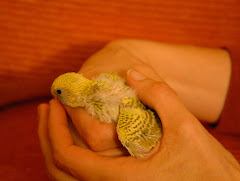
Magoo is being adopted by a very nice person who works with K. She is excited to have him as a pet, and will take good care of him. It is a necessity as he and Sutcliffe are fighting badly, daily. Someone will eventually be hurt. They are knocking each other off perches and pinning each other down on the ground or side of the cage.
Budgie-General Care
Our vet is: Animal Avian Hospital of the Village, in Rice Village. They are really into birds. 2422 Robinhood, Houston, Texas, in the Rice University Village. 713-524-3800. He doesn’t really need any care, unless you want the vet to clip his wings for you.
Food-
It is good to give them food that has a mixture of seeds and pellets. We use “eggcite” but other types are also ok.
Regular feedings:
They need their bowls filled every day. Even if it looks full, the empty husks are left on top by the budgies and they can’t find food underneath the husks; therefore, some budgies starve because their owners think they have plenty but they really don’t know how to get at it.
However, if you want to leave the budgie(s) alone for several days, leave plenty of hanging “snack sticks”. About ½ stick per day per budgie seems to be the right amount. We have left the budgies up to a week with these and while the cage is a bit messy on return, the budgies do fine.
Special foods:
They shouldn’t get treats every day, as that will make it harder to train them. Use millet seed in your hand to tame the budgie. You will have to be patient but if you try every day, in a couple weeks or so the budgie will eat millet seed while sitting on your hand!
Vegetables and fruit:
They like cilantro or lettuce, and you can give that as often as you like. (Once it is wilted it has to be removed or they get runny stools). They also like strawberries, but even ½ strawberry is more than they can eat. I usually put ½ in the cage and then when they have had it for a day, take it out before it gets gross. Apparently they aren’t supposed to eat avocado. If you want to try a new fruit or vegetable, put it in every day for a couple of weeks. The budgie will ignore it for a while then get used to it and eat it with joy.
If the budgie can’t reach his beak to get at the food, then they won’t eat it. Ditto for water bottles. So the food has to be hung near a perch at “beak height” or so.
Water:
Fresh water is important. I use a hamster style bottle. Some people use water bowls/trays. I also give them “showers” with a spray bottle about once a week. They really like it! Of course the spray bottle should be used for water only.
Perches:
It is important to have wooden perches, as budgies like to chew to keep their beaks clean and trimmed. They like pecan or maple or any fruit tree branch. Don’t use cedar or magnolia. You can also buy wooden perches. Some plastic perches are ok too, but not all perches should be plastic as that can irritate their feet. It is important that perches are placed so that they can easily stand and access food and water.
Dangers:
Sprays that smell like cleaning sprays, fluids, are dangerous. Budgies are very sensitive to chemicals (remember the “canary in the coal mine”). Sometimes they can get a toenail caught in something in the cage, so any wires used should not have loose ends sticking into the cage. Doors on the cage should be closed with a “twisty tie” so the budgie doesn’t escape. Some human foods are dangerous; check on the internet before trying if you are unsure. If they are out of the cage, getting slammed in a door, stepped on, etc are all dangers of course.
Communication:
Budgies like to be talked too. They seem to know their names, maybe. leave the radio on for them during the day to prevent loneliness and give htem something to sing too. A quiet “jngle” means “danger” so the sound makes them feel reassured. They also like to be talked to.
Training:
With a lot of attention, a budgie can get very tame, especially if talked to. Also budgies get tamer if they are the “only bird” as they see you as their flock. But don’t be fooled by affection; if the budgie gets away outside, he will fly away (mainly due to getting disoriented). The most elemental training exercise is “finger sitting”. If a budgie is not paying attention, “finger ladder walking” is a good way to help him focus.
Other thoughts:
We put the birds out in the AM (weather permitting) and inside in the PM when the weather will not go below 60 degrees. Below 60, it is too cold for them. I also like it as then seeds don’t make any mess during the day. They do throw seeds around when they eat, because they “hull” (peel) the outside of the seed off and discard it (drop it). The hull is very fine so it floats down. I use a netting around the cage that you can get at the pet store to cover the cage and it helps quite a bit.
Budgies combine urine and feces into one type of elimination. Normal is white with blackish/green middle, more or less.
History of Magoo:
Magoo was hatched in 12/07. You can see a lot of documentation about him here. http://boobudgie.blogspot.com/2007_12_01_archive.html and other places on the blog (ie, this blog!!!).







1 comment:
Bon voyage, Magoo
Post a Comment